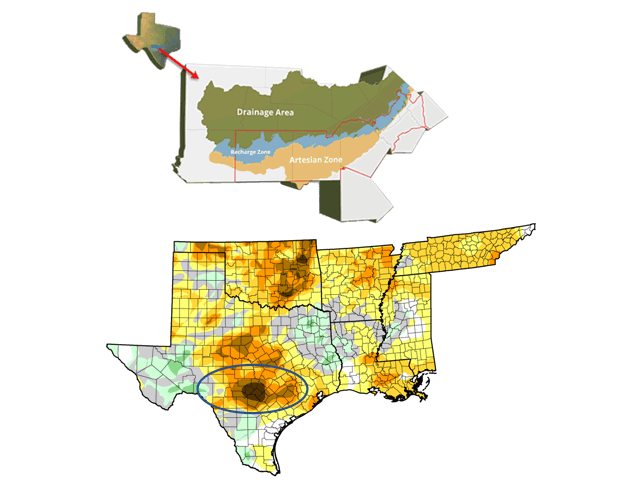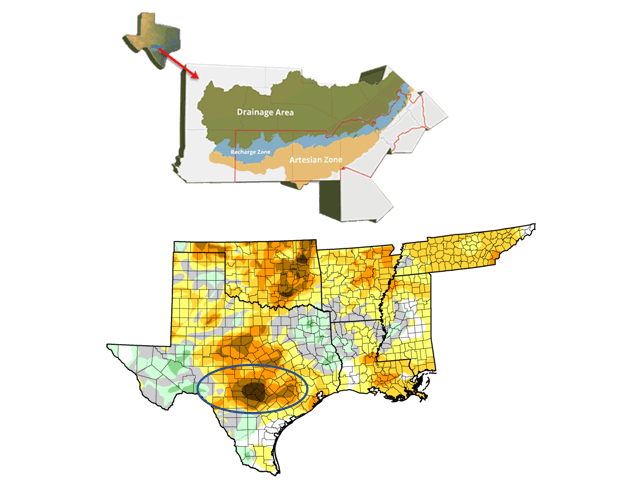Ag Weather Forum
Drought Forces Cuts in Texas Aquifer Usage
The Ogallala Aquifer is not the only major groundwater source which has had notable declines because of drought in the southern United States. In south central Texas, the Edwards Aquifer has also had a big decline in its volume to the point that withdrawals from the aquifer have been cut by up to 35% -- more than one third.
The Edwards Aquifer is located in south-central Texas and covers an area about 160 miles long from east to west and 80 miles from north to south. The aquifer supports the water supplies of almost 2 million people, including the cities of San Antonio and Austin.
During a recent webinar conducted by NOAA and the National Integrated Drought Information Service (NIDIS), Nelun Fernando of the Texas Water Development Board noted some significant features of how the groundwater supplies in Texas declined in the October 2021-to-October 2022 period. Fernando reported that groundwater conditions recorded at 18 monitoring wells in Texas showed that water levels declined in 13 of the 18 monitoring wells in September, compared to conditions in September 2021. In addition, central and south-central Texas drought assessments by the U.S. Drought Monitor indicated anywhere from three to five classes of drought degradation during this same time frame.
P[L1] D[0x0] M[300x250] OOP[F] ADUNIT[] T[]
Also, the water level at a key indicator well in the Edwards Aquifer reached the Stage 3 drought level in June 2022, resulting in a 35% reduction in withdrawals. (The Edwards Aquifer segment cited is an aquifer sector which responds to rainfall.) And, even following some fall rains, the aquifer is still below the Stage 3 "critical management" level of 640 feet as of Nov. 14.
The Edwards Aquifer is not the only water source in Texas with a major impact from drought. The year from October 2021 through October 2022 featured several reservoirs in north central and north Texas with a 40% decrease in storage along with storage declines of from 15% to 40% at reservoirs in central and south-central Texas. Nelun Fernando of the Texas Water Development Board also noted that, as of mid-November, the combined storage in 119 monitored major water reservoirs in Texas along with Elephant Butte reservoir in New Mexico was 68.2% of total capacity, about 12% below the median storage expected for this time of year.
Long-range forecasts do not indicate much improvement in the Texas groundwater situation. Drought is expected to either develop or continue for all but far western Texas during the 2022-23 winter season.
Looking further into 2023, DTN's forecast for Texas shows below-normal precipitation in central and south-central Texas continuing until the July-September period next year.
Bryce Anderson can be reached at Bryce.Anderson@dtn.com
Follow him on Twitter @BAndersonDTN
(c) Copyright 2022 DTN, LLC. All rights reserved.






Comments
To comment, please Log In or Join our Community .